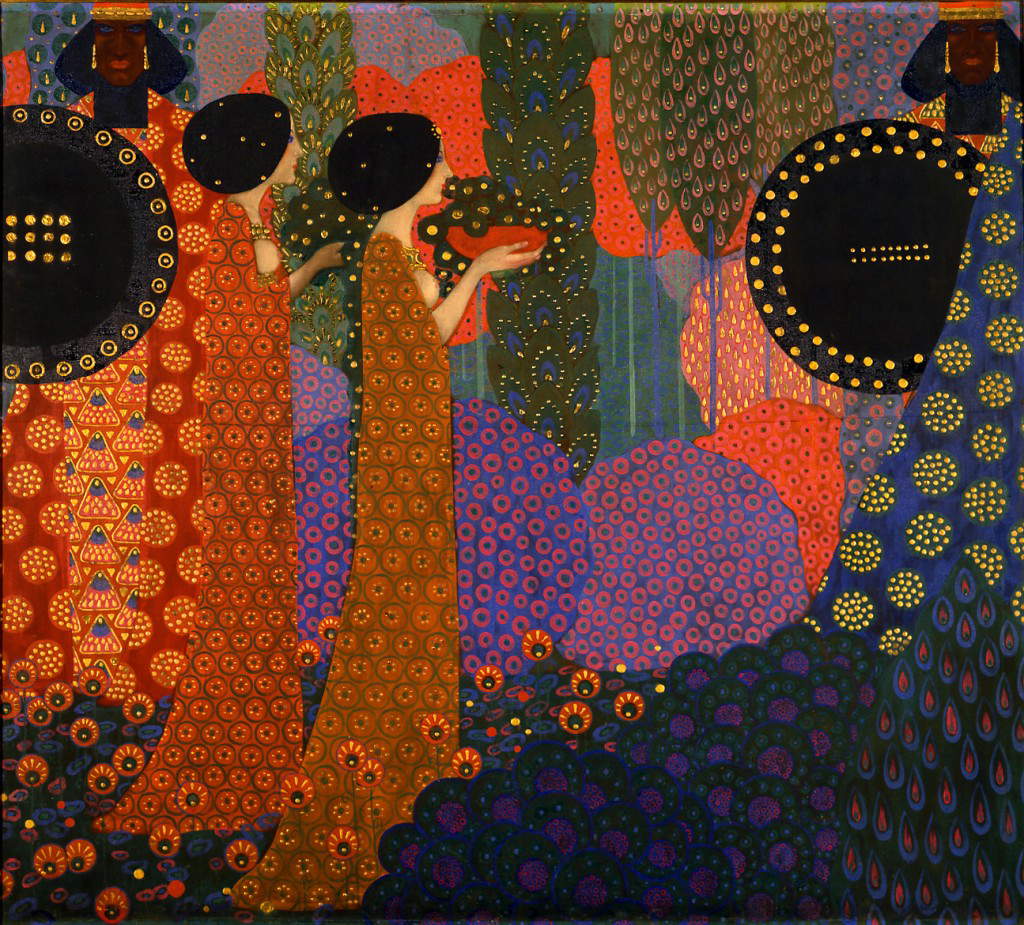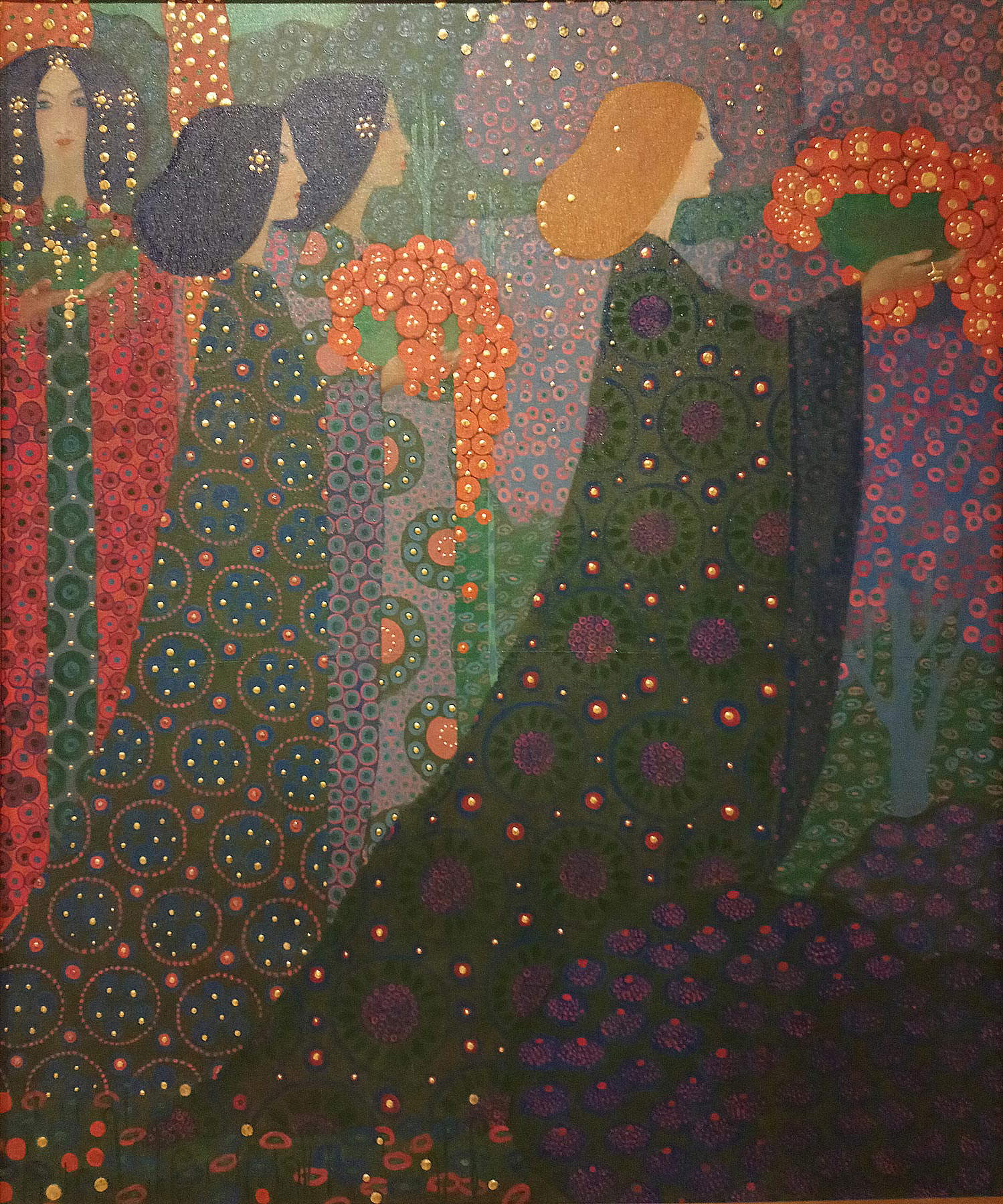Anyone looking at his works will immediately be led to think of a kind of Italian Gustav Klimt. A Venetian intoxicated by the fragrances of the Viennese secession. A young man from Murano, the son of a glassmaker, and therefore trained in the glassworks of his island, who by attending the Biennale breathes in the works that early 20th-century European artists brought to Venice every two years, and makes them his own. One could condense the beginnings of Vittorio Zecchin, one of the most original Italian interpreters of Art Nouveau, into this very rapid profile. He was a man with an imposing appearance, but a shy and shy temperament, and he was endowed with a rare and versatile sensitivity, which enabled him to open his eyes and heart to the world without ever leaving Venice, giving rise to one of the most interesting paths of early 20th-century Italy.
The peak was reached in 1914, at the age of thirty-six, when Zecchin completed the cycle of the Thousand and One Nights, probably the most famous work of his career far from the limelight and perhaps little known beyond the waters of the lagoon, from which the artist never left during his entire parabola. He was commissioned by the Hotel Terminus at the Lista di Spagna, which no longer exists, half-destroyed under the bombings of World War II that did not spare even the Serenissima. A series of rich canvases that were used to decorate a dining room and together covered about forty square meters of floor space. Then, the updates in taste that led the Terminus to restructure its spaces sanctioned the dismemberment of the cycle, which is now divided into twelve panels: of these, six are preserved at the International Gallery of Modern Art in Ca’ Pesaro, while the others ended up in private collections, some moreover recently passed at auction.
Zecchin drew inspiration from one of the best-known tales from the Thousand and One Nights, the story of Aladdin, the young man from Catai who managed to win the emperor’s daughter thanks to the copious riches that the genie of the lamp had procured for him. Curiously, the artist, in all probability, had to be inspired by a translation that Umberto Notari had published, presumably in 1913 and in an unabridged version, in the series “La Biblioteca dei Ragazzi” of the Istituto Editoriale Italiano. And, another curiosity, this translation had been illustrated by another of the greats of the time, Duilio Cambellotti, but it is likely that there was no contact between him and Zecchin.
The Terminus cycle told a precise passage in the story of Aladdin, namely the moment when the young man goes to the emperor with his pompous procession to take his betrothed in marriage. And it is an overflowing cascade of richness and sumptuousness that Zecchin profuses in his oriental-style panels, in his procession of princesses who in line, neat, in profile as if emerging from an Egyptian pyramid, covered by their hypnotic geometrically patterned gowns, bear their gifts as they advance through a magical garden, amid black warriors who stand guard, concealed behind ornate shields. A fairy tale that comes to life on the surface of a material so refined and full that it transforms the paintings into opulent fabrics. A radiant firmament of gems that the artist sets on the long robes that reach up to rub the ground, on the round shields, on the tall trees whose tops cannot be seen, on the thick bushes, on the flowery meadow. The decadent evocation of an ancient Orient, Byzantine or Persian, which in the Venice of the early twentieth century could only be imagined or dreamed of, letting oneself be carried away by the pages of the tales with which Princess Shahrazad succeeded in redeeming King Shahriyar.
 |
| Vittorio Zecchin, The Princesses and the Warriors, from the cycle The Thousand and One Nights (1914; oil and gilded stucco on canvas, 170 x 188 cm; Venice, Galleria Internazionale d’Arte Moderna di Ca’ Pesaro |
 |
| Vittorio Zecchin, Procession of Princesses, from the cycle The Thousand and One Nights (1914; oil and gilded stucco on canvas, 170 x 149 cm; Venice, Galleria Internazionale d’Arte Moderna di Ca’ Pesaro |
At the time, those “immense canvases, with fantasies of Assyrian princesses, Ethiopian slaves, black warriors on gold backgrounds, amid rivulets of silver and constellations of precious stones,” as the playwright Gino Damerini had to write in 1922, did not please: Zecchin seemed a dull, slavish imitator of Gustav Klimt. But it was Damerini himself who defended him: “he stretched, instead, on his canvases in rods, squares, triangles, in eyelets, the peacock-like surfaces of the murrine, arranging them within fantastic and flat figurations that recalled to memory glazed cartoons.”
Certainly, the distrust of those who, upon seeing such an ostentation of decorativism, of the affected pursuit of elegances, of assorted preciosities dotting even the treetops, of openings to secession, will feel a rush of revulsion, cannot be the object of blame. The panels of the Thousand and One Nights may appear excessive, in short: after all, this was a work designed for the dining room of a hotel, and it is natural that decoration should take over. However, it will also be the case to recognize that perhaps no one else, outside of Zecchin, succeeded in combining Central European innovations and Venetian tradition with such consistency. Indeed: for Mario Mondi, with this cycle, and specifically with the use of color that Zecchin demonstrates in the Thousand and One Nights cycle, the Murano painter implements “the most significant and ingenious recovery of the centuries-old and glorious artistic tradition of his city.”
In this cycle, indeed, centuries of Venetian art history follow one another, mingle, merge and meet. There is the tradition of the art of glassmaking, in which Zecchin had trained and to which he would return after abandoning painting as early as 1918, becoming artistic director of Cappellin and Venini glass and then working for various glassworks in the city. The colors and decorations of the cycle painted for the Hotel Terminus are those typical of murrine, the glass mosaics prized in every corner of the world. There is the hieraticity of Byzantine Venice, to which the elongated, distant figures of the princesses and the austere, symmetrical fixity of the warriors refer. There is the intense chromaticism of the Vivarini, for whom Zecchin developed a constant attraction, capable of manifesting itself ever since, in 1909, he had begun to show his works at the exhibitions at Ca’ Pesaro organized by the promoter Bevilacqua La Masa.
And then there are the suggestions that Zecchin was able to deduce by looking around, starting with the composition that necessarily refers to the inspiration of Klimt, whom he met at the 1910 Biennale and never abandoned: Zecchin is probably the closest of the Italian artists to Klimt, perhaps only on a par with Galileo Chini, with respect to whom, however, the approach to the Austrian genius is opposite. Two readings in which the two opposite ways of understanding art that have marked Italian history reverberate: “if Galileo Chini gives a Tuscan interpretation of Klimt’s stimuli, that is, in the sense of line, that is, of drawing, Zecchin gives a wholly Venetian interpretation, that is, in the sense of color,” Mondi wrote again. And then, the allure of the Orientalism in vogue at the time is, meanwhile, in a detail that is perhaps not noticeable at first, since it is easy to blend into the swirl of the decorations, namely the naked breasts of the offertory girls in procession. And it is then in the mystical atmosphere that he refers to the dreamy scenes of Jan Toorop, whom Zecchin had met at the 1905 Biennale, where the Dutchman had brought about twenty of his works: he was for Zecchin a sort of trait d’union between ancient and modern Europe and the mysterious Orient, which Toorop moreover knew firsthand since he was born on the island of Java.
After One Thousand and One Nights, Zecchin would gradually abandon painting and turn to the applied arts. When the painter was painting Aladdin and his enchanted court, perhaps one could still afford to fly over the imagined Orient by soaring on the flying carpets of Arab mythology, to dream of magical and distant worlds, to bask in the fantastical visions of fabulous processions of Persian princesses. Then, the following year, World War I would sound a rude and bleak awakening in Italy as well.
If you enjoyed this article, read previous ones in the same series: Gabriele Bella’sConcerto; Plinio Nomellini’sRed Nymph;Guercino’sApparition of Christ to His Mother; Titian’sMagdalene.
Warning: the translation into English of the original Italian article was created using automatic tools. We undertake to review all articles, but we do not guarantee the total absence of inaccuracies in the translation due to the program. You can find the original by clicking on the ITA button. If you find any mistake,please contact us.